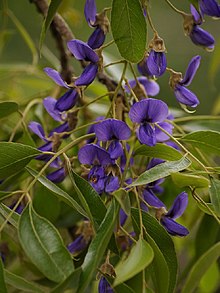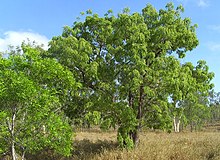bio.wikisort.org - Plant
Bolusanthus speciosus (tree wisteria) is a species of flowering plants in the family Fabaceae. It belongs to the subfamily Faboideae. It is the only member of the genus Bolusanthus .[1][2][3]
| Bolusanthus | |
|---|---|
 | |
 | |
| Habit | |
| Scientific classification | |
| Kingdom: | Plantae |
| Clade: | Tracheophytes |
| Clade: | Angiosperms |
| Clade: | Eudicots |
| Clade: | Rosids |
| Order: | Fabales |
| Family: | Fabaceae |
| Subfamily: | Faboideae |
| Tribe: | Sophoreae |
| Genus: | Bolusanthus Harms |
| Species: | B. speciosus |
| Binomial name | |
| Bolusanthus speciosus (Bolus) Harms | |
| Synonyms[1] | |
| |
Description
It is a small deciduous tree, which can grow up to 7 m (23 ft) tall. It has black, fissured rough bark and also drooping branches. Between September and October, when the tree has no leaves it begins to bloom, with lilac blue flowers. Later it produces a seed capsule, the grey pods contain 3-8 smooth, bright yellow or brown seeds.[4]
The wood is very hard, heavy and yellow in colour. It can be used for axe-handles, wagon spokes and fencing poles. The tree is also grown in gardens due to the attractive flowers.[4]
Distribution
It is native to KwaZulu-Natal and Northern Provinces (of South Africa), Eswatini, Botswana, Malawi, Mozambique, Zambia and Zimbabwe.[5] It is found in low - medium altitudes in woodland or wooded grasslands.[4]
Taxonomy
The genus name of Bolusanthus is in honour of Harry Bolus, (1834 – 1911) who was a South African botanist, botanical artist, businessman and philanthropist,[6] and 'anthus' the Greek word for flower.
It was first published and described by (Bolus) Hermann Harms (a German botanist) in Repert. Spec. Nov. Regni Veg. 2: 15 in 1906.[5]
References
- "The Plant List entry for Bolusanthus". The Plant List. Royal Botanic Gardens, Kew and the Missouri Botanical Garden. 2013. Retrieved 14 May 2014.
- "ILDIS LegumeWeb entry for Bolusanthus". International Legume Database & Information Service. Cardiff School of Computer Science & Informatics. Retrieved 14 May 2014.
- USDA; ARS; National Genetic Resources Program. "GRIN species records of Bolusanthus". Germplasm Resources Information Network—(GRIN) [Online Database]. National Germplasm Resources Laboratory, Beltsville, Maryland. Archived from the original on 24 September 2015. Retrieved 14 May 2014.
- Drummond, R.B., ed. (1972). The Bundu Book of Trees, Flowers and Grasses (2nd ed.). Salisbury, Rhodesia: Longman Rhodesia. p. 35. ISBN 058257532X.
- "Bolusanthus speciosus (Bolus) Harms | Plants of the World Online | Kew Science". Plants of the World Online. Retrieved 18 August 2021.
- Burkhardt, Lotte (2018). Verzeichnis eponymischer Pflanzennamen – Erweiterte Edition [Index of Eponymic Plant Names – Extended Edition] (pdf) (in German). Berlin: Botanic Garden and Botanical Museum, Freie Universität Berlin. doi:10.3372/epolist2018. ISBN 978-3-946292-26-5. Retrieved 1 January 2021.
 Data related to Bolusanthus at Wikispecies
Data related to Bolusanthus at Wikispecies Media related to Bolusanthus at Wikimedia Commons
Media related to Bolusanthus at Wikimedia Commons
Другой контент может иметь иную лицензию. Перед использованием материалов сайта WikiSort.org внимательно изучите правила лицензирования конкретных элементов наполнения сайта.
WikiSort.org - проект по пересортировке и дополнению контента Википедии